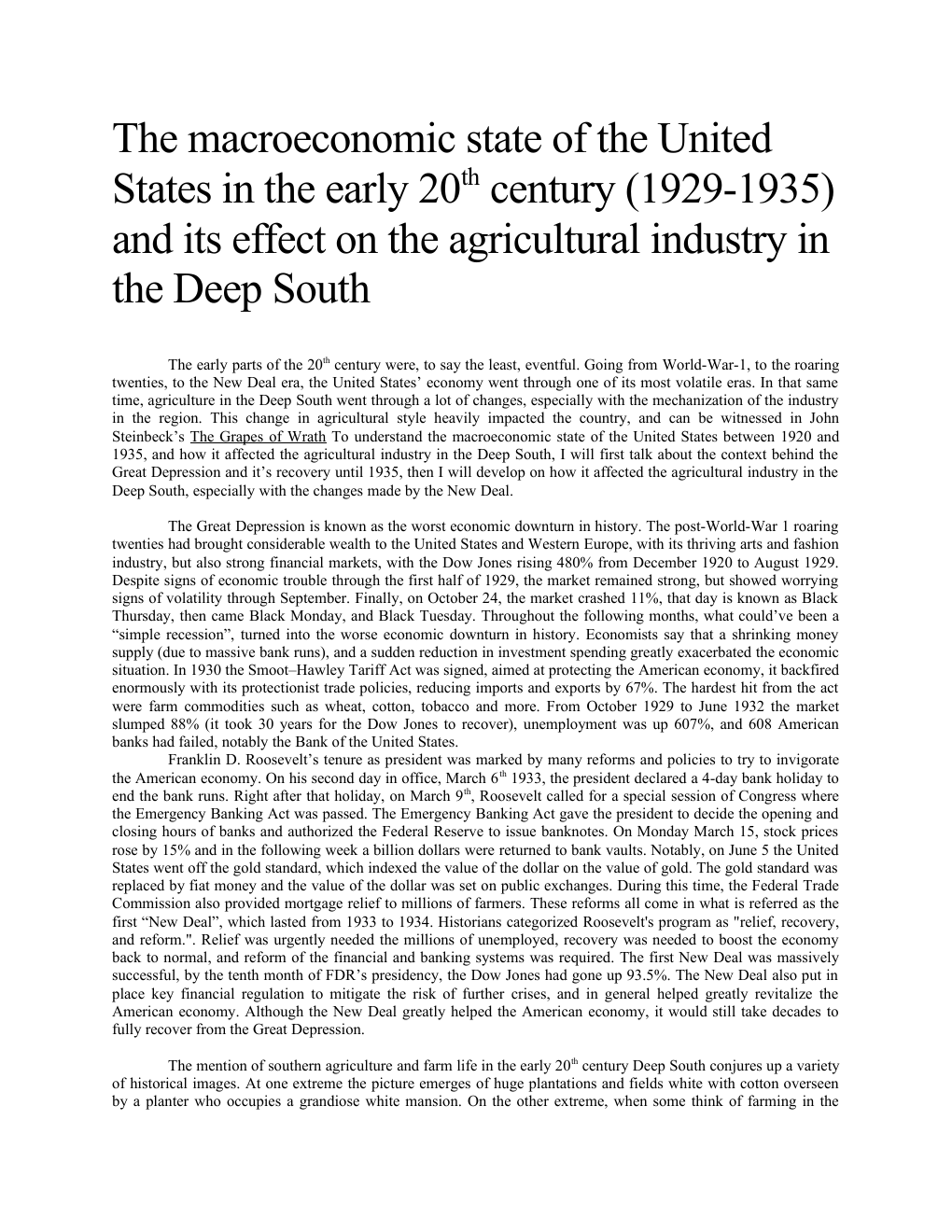Essai - L'état macroéconomique des Etats Unis lors de la Grande Dépression, et ces effets sur l'agriculture
Publié le 08/01/2024
Extrait du document
«
The macroeconomic state of the United
States in the early 20th century (1929-1935)
and its effect on the agricultural industry in
the Deep South
The early parts of the 20th century were, to say the least, eventful.
Going from World-War-1, to the roaring
twenties, to the New Deal era, the United States’ economy went through one of its most volatile eras.
In that same
time, agriculture in the Deep South went through a lot of changes, especially with the mechanization of the industry
in the region.
This change in agricultural style heavily impacted the country, and can be witnessed in John
Steinbeck’s The Grapes of Wrath To understand the macroeconomic state of the United States between 1920 and
1935, and how it affected the agricultural industry in the Deep South, I will first talk about the context behind the
Great Depression and it’s recovery until 1935, then I will develop on how it affected the agricultural industry in the
Deep South, especially with the changes made by the New Deal.
The Great Depression is known as the worst economic downturn in history.
The post-World-War 1 roaring
twenties had brought considerable wealth to the United States and Western Europe, with its thriving arts and fashion
industry, but also strong financial markets, with the Dow Jones rising 480% from December 1920 to August 1929.
Despite signs of economic trouble through the first half of 1929, the market remained strong, but showed worrying
signs of volatility through September.
Finally, on October 24, the market crashed 11%, that day is known as Black
Thursday, then came Black Monday, and Black Tuesday.
Throughout the following months, what could’ve been a
“simple recession”, turned into the worse economic downturn in history.
Economists say that a shrinking money
supply (due to massive bank runs), and a sudden reduction in investment spending greatly exacerbated the economic
situation.
In 1930 the Smoot–Hawley Tariff Act was signed, aimed at protecting the American economy, it backfired
enormously with its protectionist trade policies, reducing imports and exports by 67%.
The hardest hit from the act
were farm commodities such as wheat, cotton, tobacco and more.
From October 1929 to June 1932 the market
slumped 88% (it took 30 years for the Dow Jones to recover), unemployment was up 607%, and 608 American
banks had failed, notably the Bank of the United States.
Franklin D.
Roosevelt’s tenure as president was marked by many reforms and policies to try to invigorate
the American economy.
On his second day in office, March 6 th 1933, the president declared a 4-day bank holiday to
end the bank runs.
Right after that holiday, on March 9 th, Roosevelt called for a special session of Congress where
the Emergency Banking Act was passed.
The Emergency Banking Act gave the president to decide the opening and
closing hours of banks and authorized the Federal Reserve to issue banknotes.
On Monday March 15, stock prices
rose by 15% and in the following week a billion dollars were returned to bank vaults.
Notably, on June 5 the United
States went off the gold standard, which indexed the value of the dollar on the value of gold.
The gold standard was
replaced by fiat money and the value of the dollar was set on public exchanges.
During this time, the Federal Trade
Commission also provided mortgage relief to millions of farmers.
These reforms all come in what is referred as the
first “New Deal”, which lasted from 1933 to 1934.
Historians categorized Roosevelt's program as "relief, recovery,
and reform.".
Relief was urgently needed the millions of unemployed, recovery was needed to boost the economy
back to normal, and reform of the financial and banking systems was required.
The first New Deal was massively
successful, by the tenth month of FDR’s presidency, the Dow Jones had gone up 93.5%.
The New Deal also put in
place key financial regulation to mitigate the risk of further crises, and in general helped greatly revitalize the
American economy.
Although the New Deal greatly helped the American economy, it would still take decades to
fully recover from the Great Depression.
The mention of southern agriculture and farm life in the early 20th century Deep South conjures up a variety
of historical images.
At one extreme the picture emerges of huge plantations and fields white....
»
↓↓↓ APERÇU DU DOCUMENT ↓↓↓
Liens utiles
- USA: la grande dépression et le New Deal (Travaux Personnels Encadrés – HISTOIRE & CIVILISATION) Les Etats-Unis face à la plus grande crise économique du xxe siècle
- Etats-Unis: De la colonie à la grande puissance
- Etats-Unis: agriculture
- Comment l'espace des Etats-Unis d'Amérique est-il utilisé par l'agriculture?
- Etre citoyen en France , en Grande-Bretagne et aux Etats-Unis entre 1820 et 1848 (histoire)

































